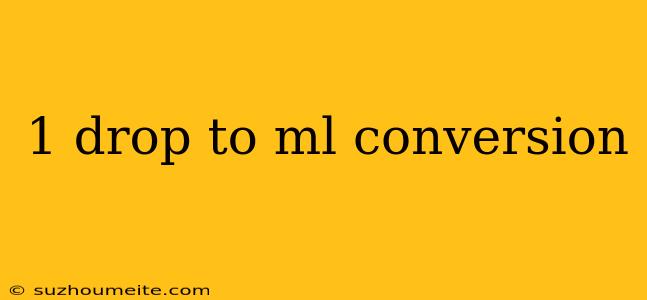1 Drop to mL Conversion: A Guide to Accurate Measurements
When working with small quantities of liquids, accurate measurements are crucial. In various fields like medicine, chemistry, and biology, precise measurements are essential to ensure the desired outcomes. One common conversion that arises in these fields is the 1 drop to mL conversion. In this article, we will explore the conversion factor, its application, and some practical examples.
What is a Drop?
A drop is a unit of volume, although not a part of the International System of Units (SI). It is commonly used in medicine, particularly in pharmaceutical and medical applications. The volume of a drop can vary depending on the surface tension and viscosity of the liquid, as well as the method of formation. Typically, a drop is considered to be around 0.05 mL.
1 Drop to mL Conversion Factor
The conversion factor from drops to milliliters (mL) is essential in various applications. The general conversion factor is:
1 drop ≈ 0.05 mL
This conversion factor is widely accepted and used in many fields. However, it's essential to note that the actual volume of a drop can vary depending on the specific application and the properties of the liquid.
Applications of 1 Drop to mL Conversion
The 1 drop to mL conversion has numerous applications in various fields, including:
- Medicine: In pharmaceutical preparations, accurate measurements are critical. The 1 drop to mL conversion helps in calculating the volume of medication to be administered.
- Chemistry: In laboratory settings, the conversion is useful when working with small quantities of liquids, ensuring accurate measurements and calculations.
- Biology: In biological research, the conversion is essential when working with microorganisms or small specimens.
Practical Examples
- A doctor prescribes 30 drops of medication to a patient. How many mL is this equivalent to?
Using the conversion factor, 1 drop ≈ 0.05 mL, we can calculate the volume:
30 drops × 0.05 mL/drop = 1.5 mL
- A chemist needs to measure 2.5 mL of a reagent. How many drops is this equivalent to?
Using the conversion factor, we can calculate the number of drops:
2.5 mL ÷ 0.05 mL/drop = 50 drops
Conclusion
In conclusion, the 1 drop to mL conversion is a crucial aspect of accurate measurements in various fields. Understanding the conversion factor and its applications can help ensure precise calculations and measurements. Whether in medicine, chemistry, or biology, this conversion is essential for achieving the desired outcomes.
